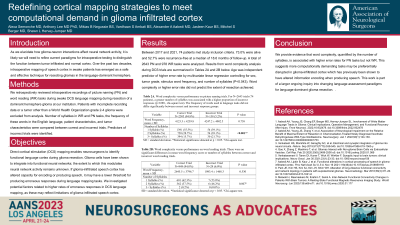Redefining cortical mapping strategies to meet computational demand in glioma infiltrated cortex
Redefining Cortical Mapping Strategies to Meet Computational Demand in Glioma Infiltrated Cortex
Friday, April 21, 2023

- AS
Alexa Semonche, MD
Resident Physician
University of California San Francisco
San Francisco, California, United States
ePoster Presenter(s)
Introduction: In resecting dominant-hemisphere gliomas, eloquent speech cortex can be identified and protected through awake intraoperative language mapping via direct cortical stimulation (DCS) with picture-naming (PN) or word-reading (WR) tasks. Recent studies have shown how glioma-infiltrated cortex within the perisylvian language network may exhibit limitations in encoding and producing speech, but it is unknown how this affects intraoperative language mapping interpretations.
Methods: Intraoperative recordings of DCS with PN/WR tasks were reviewed for patients with World Health Organization grade 2-4 gliomas who underwent awake language mapping during tumor resection at a tertiary care center. Patients with incomplete recordings or non-glioma pathology were excluded from analysis. The number of syllables in words tested in correct versus incorrect DCS trials was compared.
Results: Between 2017 and 2021, 94 patients underwent awake language mapping during tumor resection; 17 patients were excluded yielding a total of N=77 patients. Of these, 35% were female and 91% were right-handed (5% left-handed; 4% ambidextrous). Most (96%) tumors were left-sided. The average number of syllables in incorrect PN trials was significantly higher than those in correct trials (1.90 vs. 1.64, P=0.03). Through regression analysis, we find that each added syllable increases the PN error rate by 2.2%. There was no significant difference between average syllables in incorrect vs. correct WR trials (P=0.68). Severity of language impairment before surgery did not correlate with better or worse language recovery on postoperative testing (p=0.74).
Conclusion : We provide evidence that word complexity, quantified by the number of syllables, is associated with an incorrect response in PN tasks. We hypothesize that PN is a more cognitively demanding task, explaining the higher error rate in more complex trials compared to WR. This suggests more computationally demanding tasks may be preferentially disrupted in glioma-infiltrated cortex, which manifests in a limited capacity for encoding or producing polysyllabic speech.
Methods: Intraoperative recordings of DCS with PN/WR tasks were reviewed for patients with World Health Organization grade 2-4 gliomas who underwent awake language mapping during tumor resection at a tertiary care center. Patients with incomplete recordings or non-glioma pathology were excluded from analysis. The number of syllables in words tested in correct versus incorrect DCS trials was compared.
Results: Between 2017 and 2021, 94 patients underwent awake language mapping during tumor resection; 17 patients were excluded yielding a total of N=77 patients. Of these, 35% were female and 91% were right-handed (5% left-handed; 4% ambidextrous). Most (96%) tumors were left-sided. The average number of syllables in incorrect PN trials was significantly higher than those in correct trials (1.90 vs. 1.64, P=0.03). Through regression analysis, we find that each added syllable increases the PN error rate by 2.2%. There was no significant difference between average syllables in incorrect vs. correct WR trials (P=0.68). Severity of language impairment before surgery did not correlate with better or worse language recovery on postoperative testing (p=0.74).
Conclusion : We provide evidence that word complexity, quantified by the number of syllables, is associated with an incorrect response in PN tasks. We hypothesize that PN is a more cognitively demanding task, explaining the higher error rate in more complex trials compared to WR. This suggests more computationally demanding tasks may be preferentially disrupted in glioma-infiltrated cortex, which manifests in a limited capacity for encoding or producing polysyllabic speech.
